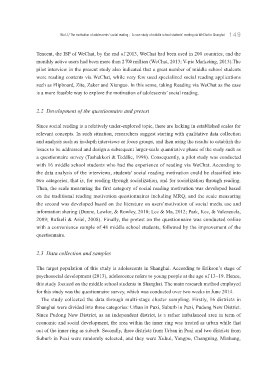Page 150 - JOURNAL OF LIBRARY SCIENCE IN CHINA 2015 Vol. 41
P. 150
Wu LI / The motivation of adolescents’ social reading:A case study of middle school students’ reading via WeChat in Shanghai 149
Tencent, the ISP of WeChat, by the end of 2013, WeChat had been used in 200 countries, and the
monthly active users had been more than 2 700 million (WeChat, 2013; V-pie Marketing, 2013).The
pilot interview in the present study also indicated that a great number of middle school students
were reading contents via WeChat, while very few used specialized social reading applications
such as Flipboard, Zite, Zaker and Xianguo. In this sense, taking Reading via WeChat as the case
is a more feasible way to explore the motivation of adolescents’ social reading.
2.2 Development of the questionnaire and pretest
Since social reading is a relatively under-explored topic, there are lacking in established scales for
relevant concepts. In such situation, researchers suggest starting with qualitative data collection
and analysis such as in-depth interviews or focus groups, and then using the results to establish the
issues to be addressed and design a subsequent larger-scale quantitative phase of the study such as
a questionnaire survey (Tashakkori & Teddlie, 1998). Consequently, a pilot study was conducted
with 16 middle school students who had the experience of reading via WeChat. According to
the data analysis of the interviews, students’ social reading motivation could be classified into
two categories, that is, for reading through socialization, and for socialization through reading.
Then, the scale measuring the first category of social reading motivation was developed based
on the traditional reading motivation questionnaires including MRQ, and the scale measuring
the second was developed based on the literature on users’motivation of social media use and
information sharing (Dunne, Lawlor, & Rowley, 2010; Lee & Ma, 2012; Park, Kee, & Valenzuela,
2009; Rafaeli & Ariel, 2008). Finally, the pretest on the questionnaire was conducted online
with a convenience sample of 48 middle school students, followed by the improvement of the
questionnaire.
2.3 Data collection and samples
The target population of this study is adolescents in Shanghai. According to Erikson’s stage of
psychosocial development (2013), adolescence refers to young people at the age of 13-19. Hence,
this study focused on the middle school students in Shanghai. The main research method employed
for this study was the questionnaire survey, which was conducted over two weeks in June 2014.
The study collected the data through multi-stage cluster sampling. Firstly, 16 districts in
Shanghai were divided into three categories: Urban in Puxi, Suburb in Puxi, Pudong New District.
Since Pudong New District, as an independent district, is a rather imbalanced area in term of
economic and social development, the area within the inner ring was treated as urban while that
out of the inner ring as suburb. Secondly, three districts from Urban in Puxi and two districts from
Suburb in Puxi were randomly selected, and they were Xuhui, Yangpu, Changning, Minhang,

